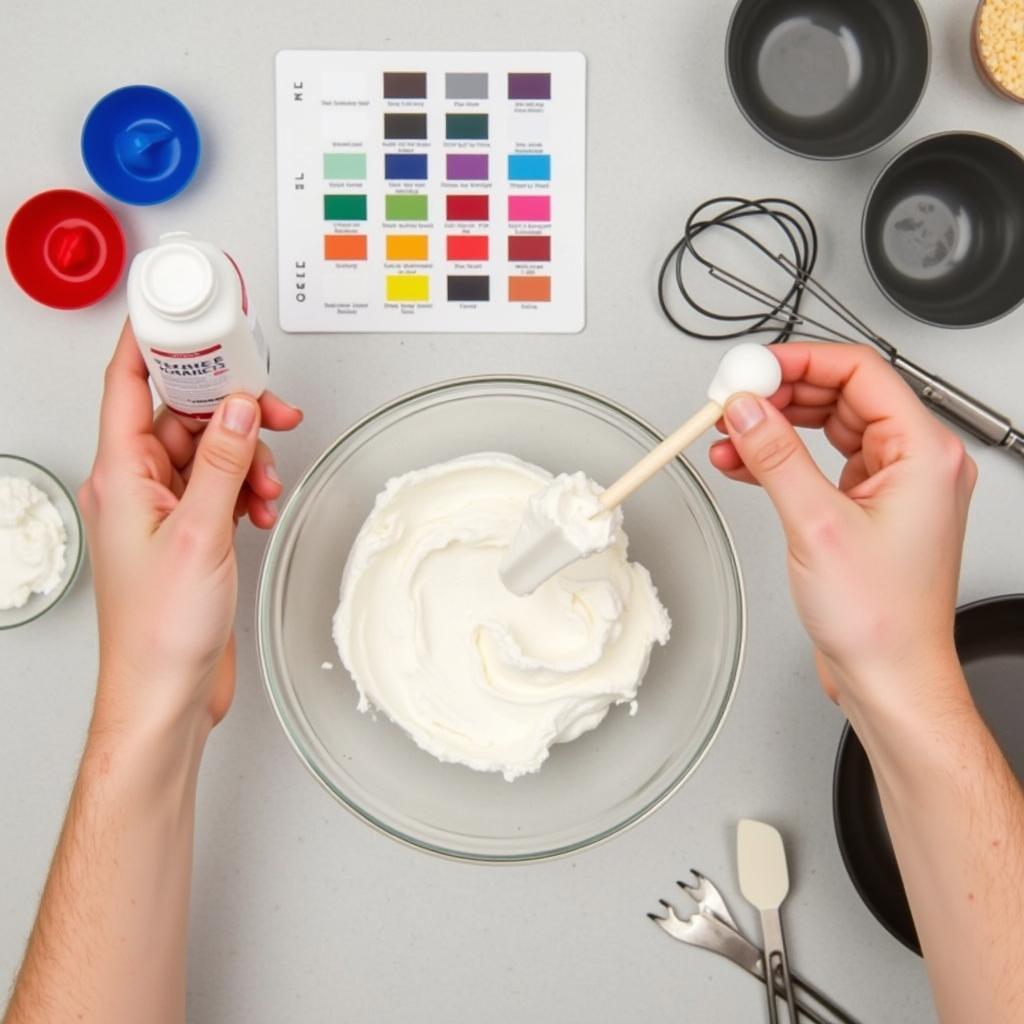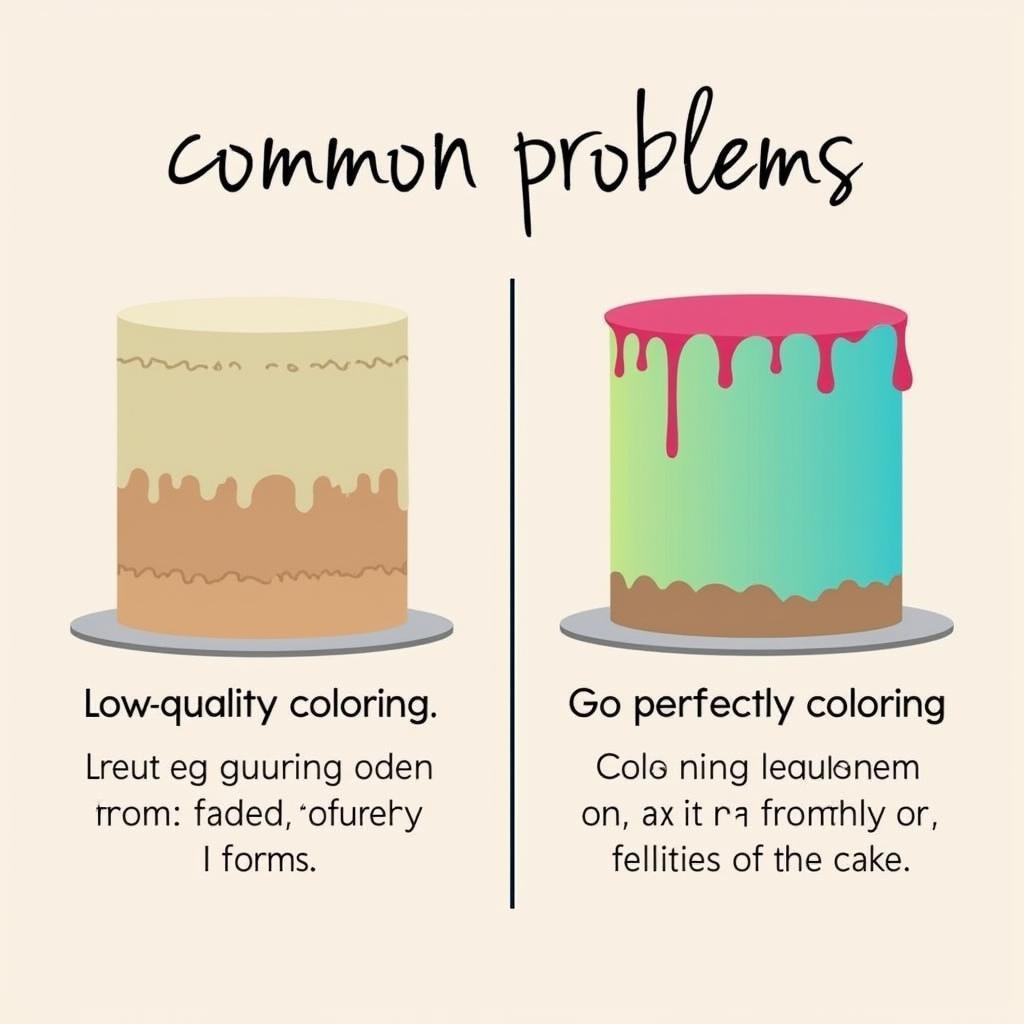Baking Food Coloring transforms ordinary treats into edible masterpieces. Whether you’re crafting a rainbow layer cake, delicate pastel macarons, or spooky Halloween cookies, understanding how to use food coloring effectively is key to achieving vibrant and appealing results. food coloring for baking offers a wide array of options for your baking needs.
A Spectrum of Choices: Types of Baking Food Coloring
Choosing the right baking food coloring can be a game-changer. From liquid drops to concentrated gels and vibrant powders, each type offers unique benefits and considerations. Understanding these differences will help you select the perfect coloring for your baking project.
Liquid Food Coloring: The Classic Choice
Liquid food coloring is a pantry staple, readily available and easy to use. Its water-based formula makes it ideal for lighter-colored frostings and batters. However, using too much liquid coloring can thin out your mixtures.
Gel Food Coloring: Concentrated Power
For deep, rich hues, gel food coloring is the way to go. A little goes a long way with this concentrated formula. Gel colors are perfect for achieving vibrant shades without altering the consistency of your batter or frosting.
Powdered Food Coloring: Intense and Versatile
Powdered food coloring offers intense color and excellent versatility. It’s ideal for coloring dry ingredients like meringue and macaron shells. While it requires pre-mixing with liquid, the powdered format allows for precise color adjustments. organic food coloring powder is a great choice for those looking for natural options.
Tips and Tricks for Using Baking Food Coloring
Achieving consistent and vibrant colors in your baked goods requires more than just choosing the right type of coloring. Here are some essential tips to help you master the art of baking food coloring:
- Start small: Begin with a tiny amount of coloring and gradually add more until you reach the desired shade.
- Mix thoroughly: Ensure the coloring is fully incorporated to prevent streaks and uneven color distribution.
- Consider your base: The color of your batter or frosting will influence the final result. White or light-colored bases provide the best canvas for vibrant hues.
- Toothpick test: Use a toothpick to add small amounts of gel or powdered color to your mixture, ensuring precise control.
 Tips for Using Baking Food Coloring
Tips for Using Baking Food Coloring
Baking Food Coloring for Special Occasions
Baking food coloring isn’t just for everyday treats; it’s the secret weapon for creating show-stopping desserts for special occasions. From festive holiday cookies to elaborate birthday cakes, food coloring christmas opens a world of creative possibilities.
Creating Thematic Color Palettes
Think beyond single colors and explore thematic color palettes. For example, pastels for Easter, jewel tones for Christmas, and vibrant neons for summer celebrations. where can i buy gel food coloring will help you find the perfect shades for any occasion.
“Understanding the nuances of baking food coloring empowers bakers to create visually stunning and delicious treats,” says renowned pastry chef, Amelia Dupont. “From subtle hints of color to bold and vibrant shades, the possibilities are endless.”
Troubleshooting Common Baking Food Coloring Issues
Sometimes, achieving the perfect color isn’t as straightforward as it seems. Here are solutions to common baking food coloring challenges:
- Faded colors: If your colors fade after baking, try using a higher quality or more concentrated coloring.
- Uneven coloring: Thorough mixing is crucial for preventing streaks and blotches.
- Color bleeding: Certain colorings can bleed into surrounding frosting or batter. Using a thicker consistency can help prevent this.
 Troubleshooting Baking Food Coloring Issues
Troubleshooting Baking Food Coloring Issues
Conclusion
Baking food coloring allows us to transform simple ingredients into vibrant works of art. By understanding the different types of coloring available and mastering a few key techniques, you can elevate your baking to new levels of creativity and visual appeal. So, go ahead and experiment with baking food coloring – food coloring bulk can be a cost-effective option for frequent bakers – and let your imagination run wild!
FAQ
- What is the best type of food coloring for macarons?
- Can I mix different food colorings together?
- How do I achieve a specific shade of color?
- What are natural food coloring alternatives?
- How do I prevent food coloring from staining my hands?
- Can I use baking food coloring in buttercream frosting?
- How do I store leftover food coloring?
Common Scenarios and Questions:
Scenario: A baker is making a rainbow cake and finds that the colors are bleeding into each other.
Question: How can I prevent colors from bleeding in a layered cake?
Answer: Use a thicker batter and ensure each layer is completely cool before adding the next.
Scenario: A baker wants to achieve a deep red color for Valentine’s Day cookies but the color appears too light.
Question: How do I get a more intense red color for my cookies?
Question: What are the best food coloring brands for vibrant colors?
More Resources on Mina Cones Food:
- Check out our article on Natural Food Coloring Alternatives.
- Learn more about Frosting Techniques and Decorations.
Contact Us:
For assistance, contact us at Phone: 02437655121, Email: minacones@gmail.com or visit our address: 3PGH+8R9, ĐT70A, thôn Trung, Bắc Từ Liêm, Hà Nội, Việt Nam. We have a 24/7 customer service team.